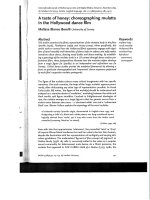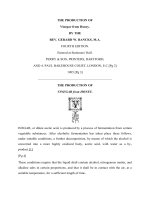Taste of honey
Bạn đang xem bản rút gọn của tài liệu. Xem và tải ngay bản đầy đủ của tài liệu tại đây (12.06 MB, 701 trang )
OTHER BOOKS BY MARIE
SIMMONS
Fresh & Fast Vegetarian
Things Cooks Love (Sur La Table)
Soups and Stews (WilliamsSonoma)
Fig Heaven
Essentials of Healthful Cooking
(Williams-Sonoma)
The Amazing World of Rice
Cookies (Williams-Sonoma)
The Good Egg
Puddings A to Z
Pancakes A to Z
Muffins A to Z
Bar Cookies A to Z
Holiday Celebrations (WilliamsSonoma)
Fresh & Fast
Lighter, Quicker, Better (with
Richard Sax)
The Light Touch Cookbook
Rice: the Amazing Grain
365 Ways to Cook Pasta
Italian Light Cooking
Better by Microwave (with Lori
Longbotham)
Good Spirits (with Barbara J.
Lagowski)
Contents
Acknowledgments
introduction
What Is Honey?
The Life of Bees
Bee Society
The Anatomy of a Bee
The Role of the Beekeeper
Honey and Terroir
The Colors of Honey
Types of Honey
Honey and Healing
What Is Propolis?
chapter 1: tasting and
cooking with honey
The Taste of Honey: A Guide to Honey
Varieties
Guidelines for a Honey Tasting
Honey and Cheese Tasting
Cooking with Honey
chapter 2: breakfast and
snacks
chapter 3: main dishes
chapter 4: salads and
vegetable side dishes
chapter 5: sweets
Baking with Honey
Bibliography
Sources
Metric Conversions and Equivalents
Index
acknowledgments
It takes many minds and multiple
palates to make a cookbook. The
primary instigators of this book are
at the top of my thank-you list: Jean
Lucas, my editor and the brain
behind the idea of writing a
cookbook to sort out the different
honeys she encountered at her local
farmers’ market; Kirsty Melville,
executive vice president and
publisher at Andrews McMeel
Publishing; and Carole Bidnick, my
terrific agent, who suggested that I
be the writer for this project.
Heartfelt thanks to the team at
Andrews McMeel for the exquisitely
designed pages of this book. Thank
you to photographer Meg Smith, food
stylist Nani Steele, and props from
Christine Wolheim for stunningly
beautiful work. You, along with your
assistants, are all artists. A special
thank-you to Rob Keller of Napa
Valley Bee Company, beekeeper par
excellence, for supplying honey,
hives, and the beautiful honey bees
for the photographs. Thank you also
to my copy editor, Tammie Barker,
for giving my work the polish it
needed. A special thank-you to
Emily Farris in advance of working
with her on publicity. I am grateful to
all of you.
Without the hard work of others,
who spent hours and possibly years
documenting the activities in the
hive, keeping the bees healthy,
working in labs and compiling
historical records and references,
and writing excellent books about
bees and honey, the information in
this book would be a bit puny.
Several of you are mentioned in the
text, and the rest can be found in the
bibliography. I am grateful for your
hard work, for it not only gave me
knowledge and understanding but
also fired my enthusiasm for honey,
bees, and beekeepers to the point
where I am now a bit of a bee—and
honey—maniac.
May Berenbaum, a professor of
entomology at the University of
Illinois at Urbana Champaign,
deserves special mention because it
was in one of her many books,
Honey, I’m Homemade, that I
found the precise answer to a
nagging question, “What is honey?”
Professor Berenbaum’s excellent
explanation—gratefully
acknowledged here—helped me
write a clear answer to this question.
Thank you, Professor Berenbaum,
for generously agreeing to vet
portions of A Taste of Honey for
me.
This book, because it is primarily a
guide to honey varieties and a
cookbook, translated into many
happy—and somewhat sticky—hours
spent in the kitchen tasting, testing,
and tasting some more. Just days into
the project I began calling my work
space “the sticky kitchen” and was
tempted to change the title to The
Sticky Kitchen Cookbook.
Stickiness did little to deter from my
ever-increasing excitement for the
subject, however. I started out liking
honey a lot and ended up loving it. I
also fell in love with the bees.
In addition to the bees, I am grateful
for the generous support and
assistance with honey and bee
sleuthing I received from colleagues,
friends, and family. They are too
numerous to mention here, so I will
name just a few: Helene and Spencer
Marshall, longtime Napa Valley
beekeepers, for your kind
hospitality; Matt Bennett, for
bringing a frame with wax
honeycomb, dripping with raw
honey, from his wife Ashley’s
beehive to a honey tasting I hosted
for the San Francisco Professional
Food Society; the National Honey
Board, for its excellent, fact-filled
website and support for this project;
David Guas, honey aficionado and
chef proprietor of Bayou Bakery in
Arlington, Virginia, for introducing
me to Appalachian sourwood at a
tasting hosted by the honey board;
Linda Sikorski and Juliana Uruburu
of Market Hall Foods in Oakland,
California, and The Pasta Shop in
Berkeley, for more honey tasting and
an insightful honey and cheese
pairing experience; Brooke Jackson
and Nancy Kux, for retesting a few
recipes; Laura Brainin-Rodriguez,
for nutritional wisdom, research, and
friendship; Paula Hamilton and Pam
Elder, dear friends and tireless
researchers, for sending media alerts
and honey factoids my way; Jenny
and Hari Krishnan, neighbors and
enthusiastic tasters; and Kathleen de
Wilbur, Kathleen O’Neil, Debbie
Rugh, and friends in my book club
for keeping me sane.
And then there is my sweet and
concerned family, who watched over
me as I worked my way through this
cookbook: John, my best friend and
husband; Stephanie, our amazing
daughter; Shawn, our thoughtful sonin-law; Seraphina, our beautiful and
smart granddaughter; and Joseph, our
adorable grandson, who at the age of
three insisted that my honey
chocolate cake needed chocolate
icing, inspiring yet another honey
recipe.
“Well,” said Pooh, “it’s the middle of the
night,
which is a good time for going to sleep.
And tomorrow morning we’ll have some
honey for breakfast.”
—The House at Pooh Corner, A. A. Milne
introduction
Quite by coincidence, I ate honey for
breakfast, too. But, unlike Pooh, I ate
honey not by scooping it with a furry
paw from the “hunny” jar, but dribbled
onto a bowl of steaming oatmeal where
it made a moatlike circle around a
melting nugget of butter. Throughout my
childhood, happiness was honey for
breakfast. And when oatmeal wasn’t on
the menu I slurped at honey combined
with melted butter dripping from the
nooks and crannies on a toasted English
muffin and washed it down with honeysweetened hot tea diluted with milk.
These are still some of the ways I love
the taste of honey.
Of course, as a child I didn’t know about
different varieties of honey. Inside the
jar on our breakfast table was most
likely orange blossom or clover honey
from the supermarket. But I also
remember big jars of local honey
purchased at farm stands along the
country roads that wound through New
York State’s Hudson River Valley,
where I grew up.
Today on the shelf in my pantry is a
charming bear-shaped plastic bottle
filled with honey. For years this iconic
bear with the yellow cap was the only
honey I used. During my years as a test
kitchen editor at magazines, I made
cakes, cookies, ice cream, and candy
with honey of unspecified varieties. But
my true honey epiphany—of sorts—
came well into adulthood on a trip to
Italy, where I was served a local
chestnut honey spooned over a thin slice
of oozy Gorgonzola dolce. I was
enthralled with the combination. Honey
and cheese? A classic pairing in the
Lombardy region was a revelation.
Sweet, salty, and bitter all congregated
on my palate at the same time. My mouth
was thrilled, and I was hooked (see
Honey and Cheese Tasting).
Once home in my own kitchen, with a
modest stash of Italian chestnut honey
now a pantry staple, I began to take
notice of the different varieties of honey
in specialty shops and at farmers’
markets. Today my collection of honey
has labels that read like a travelogue:
cranberry honey from Michigan,
rosemary and black sage honey from the
California Sier-ras, tupelo honey from
Florida, oregano honey from Sicily,
macadamia blossom honey from Hawaii,
lavender honey from southern Oregon,









